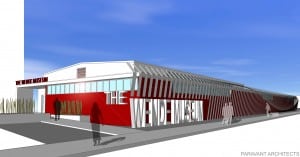

This past Sunday afternoon, around thirty Culver City residents had the opportunity to enjoy a very unique tour of a singularly unique Culver City museum. The guests, mostly neighbors of the armory in Veterans’ Park, got to peak behind the Iron Curtain at the Wende Museum, inauspiciously located in a business park in Fox Hills.
I say Iron Curtain, because the Wende houses the largest collection of Cold War artifacts in the world: You know, that time that most of us grew up in; where we had the ever-present threat of nuclear annihilation, hated the Soviet Union, boycotted Olympics, the Bay of Pigs, the Cuban Missile Crisis, the KGB vs. the CIA, the Vietnam War…
Celebrating its ten-year anniversary, the Wende has outgrown its walls. With less than one percent of its collection on exhibit, the public is missing an opportunity to see, touch and hear the voices of an era that dominated global geopolitics for much of the 20th century.
It is because of obvious size constraints and a lack of suitable exhibition space that the Wende has sought out the Armory as its new home. Museum founder, Justinian Jampol doesn’t just work in Culver City, he also lives here, and he deeply respects the need for community support when proposing any change to our neighborhood. This was the impetus for our tour.
Outside their small exhibition space, almost hidden from view is a twelve-foot high swatch of the Berlin Wall, painted with vibrant images by renowned street artist, Thierry Noir. With the fall of the Berlin Wall symbolizing the beginning of the end of the Cold War, it seems an odd juxtaposition that a piece of it stands almost unnoticed in a quiet American business park.
Walking into suite E (the unit that the Wende occupies), the last place you would think you were entering is a museum. Our tour began by climbing a flight of stairs to a room that is maybe 300 square feet in size. With four walls, the room uses its space efficiently, displaying Hungarian dissident artwork, artisan porcelain plates and historic Communist Party sculptures.
Upstairs, there are two other rooms, each smaller than the one before, and each displaying only a very small sample of the museum’s massive collection. This is why it isn’t until you peel back the façade, that you witness the heart and soul of the museum.
After, a brief history of the museum and an explanation of their plans for the armory, you could almost hear the drum roll as Justinian explained the significance of what we were about to see next.
Justinian opened a door, and we entered a massive warehouse from the second floor. My first thought as I took it all in was the final scene from Raiders of the Lost Ark, when the crated Ark of the Covenant is forklifted onto a stack of other crates in a warehouse that seems to have no end. This is an exaggeration when describing the Wende, but not in the visceral sense. There are rows of shelves, stacked 15-feet high with artifacts including, sculptures, paintings, prints, engravings, documents, flags and banners, military uniforms, photography, film, books and periodicals, and every day consumer goods.
The Wende does not only capture a sense of the Soviet controlled state of being through its art, but it touches the senses by remembering the culture through every day items such as a children’s board game, or a transistor radio or even a plastic vase. And memories are captured through recorded personal stories from people who lived and experienced Soviet rule.
As we exited the warehouse on the ground floor, our final stop on the tour took us into a room that is dedicated to the East German secret police, known as the Stasi. The oppressive agency was known for its dedicated efforts in surveillance of its own people. Spy equipment, facial recognition techniques, and an exhibit on Checkpoint Charlie are all on display here.
Our brief tour of the museum was a valuable reminder of how fortunate we are to share the freedoms we have in America. The hidden location of the Wende and limited exhibition space available makes one wanting more.
Culver City needs the Wende in Veterans’ Park. The space at the Armory would give them 7000 square feet, enough room to display the treasures that they have packed in a Fox Hills. They already provide an amazing cultural benefit to our community, but the proximity of the Armory to our schools and Justinian’s enthusiasm for partnering with our school district through educational programming would be a unique and lasting benefit that no other school district in the country could claim.
This move would also transform an eyesore into a destination. There are plans to incorporate the largest collection of the Berlin Wall outside of Germany into an outdoor garden and gathering area if their goal comes to fruition. This is a truly amazing opportunity.
If you have any questions or concerns about the Wende’s proposed move, please contact Justinian Jampol at [email protected]


Yes! The Wende really needs a new location, just like The Culver City Historical society neeeds a more prominent place in the city thant he backroom of the Vets building.
The Wende is an important cultural treasure and it is a shame that most of the artifacts are housed in the warehouse and not put on display where they need to be seen.
Culver City needs to be able to provide non-profit arts organizations with incentives to keep them within the city. Already there are so many wonderful organizations that have left or are contemplating on leaving due to the City’s constant raising of rent fees and no acknowlegement from the city government. I remember Jampol and other art-based organizations bringing this issue up with the City Council years ago, but aparently nothing has been done.